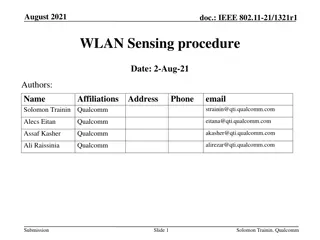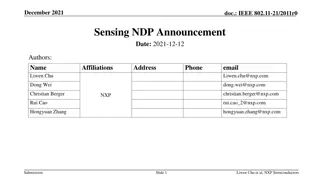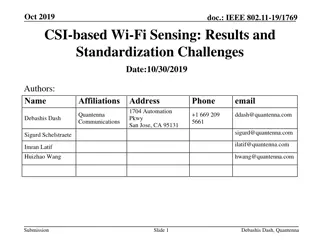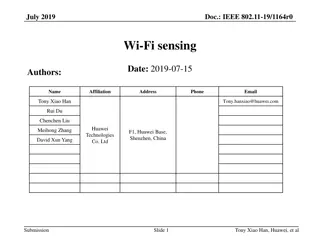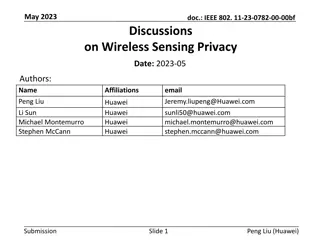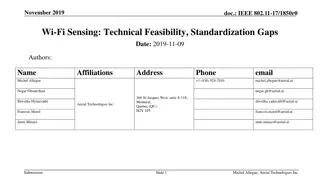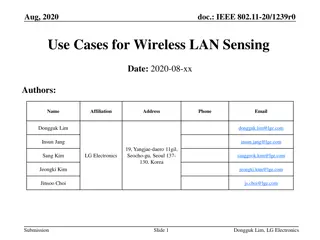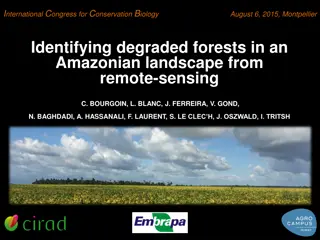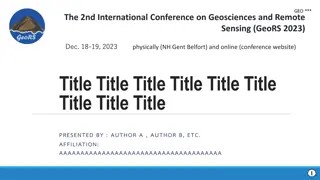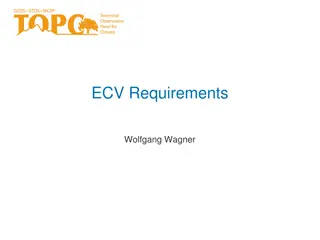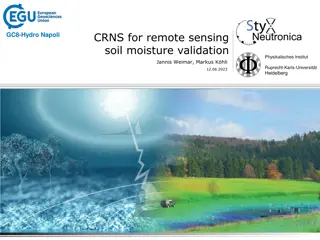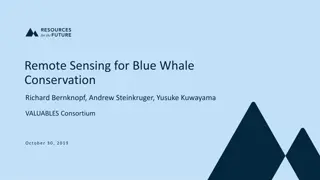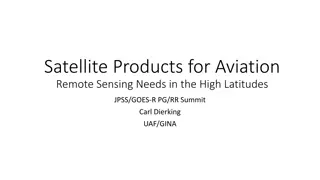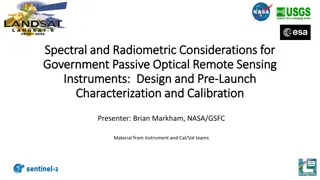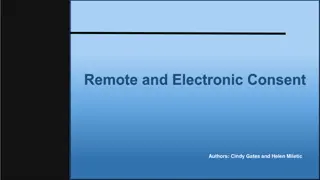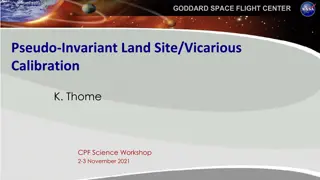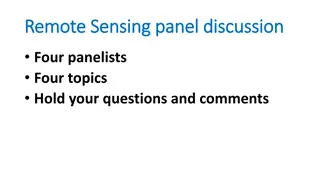Exploring Applications of Remote Sensing in Environmental Studies
Dr. Sanjib Pramanik, an Assistant Professor at Durga College, delves into the fascinating realm of remote sensing for environmental studies. Remote sensing allows data collection from a distance, utilizing methods like air photos and satellite imagery. The environment comprises components such as natural, cultural, and biological elements like mountains, seas, animals, and bacteria. Spatial and spectral resolutions play crucial roles in detecting details in images, while radiometric and temporal resolutions impact the sensitivity and data frequency. Various environmental satellites, including GOES and NOAA, facilitate Earth observation for a better understanding of our planet.
- Remote Sensing
- Environmental Studies
- Spatial Resolution
- Spectral Resolution
- Environmental Satellites
Download Presentation

Please find below an Image/Link to download the presentation.
The content on the website is provided AS IS for your information and personal use only. It may not be sold, licensed, or shared on other websites without obtaining consent from the author. Download presentation by click this link. If you encounter any issues during the download, it is possible that the publisher has removed the file from their server.
E N D
Presentation Transcript
Name : Dr. Sanjib Pramanik Name of the College : Durga College, Raipur (C.G.), India Name of the Faculty : Arts Designation : Assistant Professor, Department of Geography Topic : APPLICATION OF REMOTE SENSING ON ENVIRONMENTAL STUDY Date : 27/02/2024
Remote Sensing object at a far distance without any physical contact. Remote sensing is an art or science of collecting data (information) from an REMOTE SENSING DATA: . Air Photo Satellite Imagery
Component of Environment Natural Environment cultural Biological
Mount- ains Insolation Seas Natural environ ment Tides soils Wind Rivers Minera ls
Bacteria Animals Viruses Biological Environment Parasite s Plants
Polity Cultural environment Society Economy
Resolution Spatial resolution : The details visible in an image is dependent on the spatial resolution of the sensor and refers to the size of the smallest possible features that can be detected. It is dependent on the instantaneous field of view (IFOV) of the sensor. Spectral resolution : Spectral resolution describes the ability of a sensor to define fine wavelength intervals. The finer the spectral resolution , the narrower the wavelength ranges for a particular channel or band.
Radiometric resolution : While the arrangement of pixels describes the spatial structure of an image, the radiometric characteristics describe the actual information content in an image. The finer the radiometric resolution of a sensor, the more sensitive it is to detecting small difference in reflected of emitted energy. Temporal resolution : Temporal resolution refers to the frequency of obtaining data over a given area . It is related to revisit period. The absolute Temporal resolution of a remote sensing system to image the exact same area at the same viewing angel a second time is equal to this period.
Environmental Satellite GOES (GEOSTATIONARY OPERATIONAL ENVIRONMENTAL SATELLITE) 15 Satellites, 3 in operation GOES 13 GOES 14 GOES 15 POLAR OPERATIONAL ENVIRONMENTAL SATELLITES 10 Satellites 6 in operation. NOAA-15 NOAA-16 NOAA-18 NOAA-19 METOP-B METOP-A A FULL SIZE MODEL OF AN EARTH OBSERVATION SATELLITE FROM ESA , ERS 2
INDIAN SPACE RESEARCH ORGANIZATION (ISRO) Oceansat-2 23 IMS-1 28 Cartosat-2A CARTOSAT-2 IRS P5 (CARTOSAT-1) IRS P6 (Resourcesat 1) IRS-P4 27 IRS-P3 21 IRS-P2 15 IRS P1 IRS-1D 29 IRS-1C 28 IRS-1B 29 IRS-1A 17
METEOSAT WEATHER Meteosat 5 Meteosat 6 Meteosat 7 Meteosat 8 Meteosat 9 TIROS-1 TIROS-2 TIROS-3 TIROS-4 TIROS-5 TIROS-6 TIROS-7 TIROS-8 TIROS-9 TIROS-10 RADARSAT series RADARSAT-1 RADARSAT-2
MAJOR PROBLEMS OF ENVIRONMENT Global warming Economic Imbalance Deforestatio n Problem Increase disease Hazard Pollution
Application Of Remote Sensing On Environmental Study Hazard And Disaster Management Natural Resource Bio Diversity Agricultural Soil Moisture Crop Type Mapping Water Crop Damage Assessment Forestry Flood Landscape Ecology Wildlife Habitat Mapping Landslide
REMOTE SENSING APPLICATION ON FORESTRY Wood Deforestation
REMOTE SENSING APPLICATION FOR FORESTRY forestry utilize a particularly diverse range of remote sensing application. Forestry application of remote sensing include following Forest is an important global resources both commercial and non commercial Forest cover type discrimination 1. RECONNAISSANCE MAPPING Agro forestry mapping
REMOTE SENSING DATA USED IN FOREST APPLICATION Multitemporal data provides for change detector analysis . High resolution data provide a detailed view of forest loss . Clear-cut mapping and monitoring require regional scale images and or high resolution data . Radar data differentiate mangrove from other land cover. Thermal data used for detecting and mapping ongoing fire. Multispectral data for observing stages of growth. Satellite VNIR data for used for executing reconnaissance level forest surveys.
SATELLITE IMAGE OF DEFORESTATION Comparison of an aerial photograph (bottom) with a radar image (top) of deforestation along a road
Detection of forest fires (Canada) NOAA-AVHRR image A = Burned areas B = Fort Norman C = Norman Wells
APPLICATION OF REMOTE SENSING FOR WATER RESOURCE There can be almost endless applications of the powerful remote sensing and geographic information technique to tackle problems related to land surface sea surface and atmospheric features and processes . and utilization of water resources Remote sensing methods are adopted for the identification, investigation, planning
NEED FOR REMOTE SENSING IN WATER RESOURCE To assess the water potential in the surface . To assess the water quality . Micro water shed planning . Ground water potential . National water plan development studies . Surface water inventorying and surveying .
FOLLOWING ARE THE REMOTE SENSING DATA USED IN WATER RESOURCE STUDY IRS-1D Band 2&3. Temporal data for seasonal variation at least three data in a year. PAN data which give 3-D perspective of an area. Radar data- for ground water potential . IRS PAN -for micro water shed planning .
Acquisition of satellite data FCC print at 1 : 250000 Preliminary interpretation of enlarged images at 1 : 250000 Base map preparation Collateral data Ground check Final interpretation Preparation of final hydrological map Fig: Flow chart of methodological adopted
APPLICATION OF REMOTE SENSING ON CROP TYPE MAPPING It is one of the most important to identify and mapping of crops by remote sensing . THIS SERVICE THE PURPOSE OF : Forecasting grain supplies . Factor influencing crop stress. information in order to map crop type and acreage. Assessment of damage crop due to storms and drought . Remote sensing offered an efficient and reliable means of collecting the information about the health of Remote sensing preceding a synoptic view which can provide structured vegetation .
CROP MONITORING AND DAMAGE ASSESSMENT Early Good agricultural productivity Prevention and cure detection of crop disease Crop health
APPLICATION OF REMOTE SENSING ON SOIL MOISTURE instead of at discrete point locations that are inherent with ground measurement . Remote sensing offers a means of measuring soil moisture across a wide area measurement . RADAR is effective for obtaining qualitative imagery and quantitative RADAR back scatter response affected by soil moisture . Multi temporal radar images show the change in soil moisture over time .
SOIL MOISTURE FROM RADAR IMAGE Wet areas due to recent precipitation show up bright in the image (bottom half)
REMOTE SENSING APPLICATION ON FLOOD DELINEATION AND MAPPING target rescue efforts and to provide quantifiable estimates of the amount of land and infra structure affected Inco-operating remotely sensed data into a GIS allows for quick calculation and assessment of Remote sensing are used to measure and monitor the extend of flood areas to efficiently Water levels Damage Areas fusing potential flood danger are important for planning of transportation routing. The identification and mapping of flood plains, abandoned river cannels and meanders
RADAR SATELLITE IMAGE OF FLOODING A = Flooded area (dark) B = Town (bright) C = Railroad (bright line) D = Farmland
REMOTE SENSING APPLICATION ON LANDSLIDE MAPPING primarily through the analysis of Satellite imagery has been used in the analysis of landslide occurrence color composites. Several studies have experimental with a use of true color composites. with only landslides of approx 50 m. In most cases the primary restriction has proven to be spatial resolution X 50. m or larger being easily resolved. of IRS 1 instrument. Rather batter result were achieved using the 5.8 m. spatial resolution a clear change in the surface properties. False color composites (FCC) have used where scare landslide provides permanently wet soil, which were On the other hand used the LANDSAT thermal bonds to identify areas of linked with potential landslides.
REMOTE SENSING APPLICATION ON LANDSCAPE ECOLOGY and natural resource management and its multi spectral capability present a perspective sensed data can be collected at multiple scale at multiple time ,therefore analysis of various phenomena on global scale drought time . Remote sensing plays an important role in analysis of environmental ,cultural NEED: Inventory and mapping of resource Qualification of environmental characteristics . and alternative solution for eco system management . Describing the flows of matter and energy of eco system and evolution changes defect and observer temporal changes and habitat conditions . Identify community characteristics from a synoptic perspective, the ability to
REMOTE SENSING APPLICATION ON WILDLIFE HABITAT MAPPING Remote sensing has great potential in wildlife management land cover food value and water resource are required for habitat ,the change of habitat due to Degradation due to reduction the canopy density . Fragmentation over forest area . Degradation due to fire . Over grazing and cultivation . NEED: genetic exchange . Monitoring the physical settings of protected area and land cover changes . Monitoring of the corridors of the protected area, important population migration and Monitoring of positive and negative impacts on the habitat conditions . Management and monitoring of various changes in the flora and fauna .





